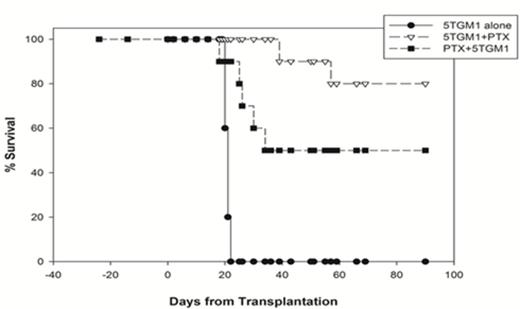Abstract
The 5TGM1 transplanted C57BL6/KaLwRij mouse is widely used to study murine multiple myeloma development. It recapitulates many features of human multiple myeloma including monoclonal paraprotein as well as bone lesions. Using this mouse model we demonstrated the crucial role of the parathyroid hormone 1 receptor (PTH1R) on the survival of mice exposed to proteasome inhibitor drugs such as bortezomib and carfilzomib; specifically the blockage of the PTH1R function by parathyroid hormone antagonist (PTH 7-34) resulted in significant abrogation of the beneficial survival effect of proteasome inhibitor drugs. To further investigate the effect of the parathyroid hormone (PTH) axis on murine myeloma development we performed thyroparathyroidectomy on the C57BL6/KaLwRij mouse before or after 5TGM1 transplantation.
Thyroparathyroidectomy was performed by trained personnel in general anesthesia with isoflurane; all surgical/postsurgical procedures and animal welfare followed an IACUC approved protocol at the University of Arkansas. To prevent hypocalcaemia at postsurgery, 1M CaCl2 solution in the drinking bottle was supplemented for a week. All tested mice received 0.5X106 5TGM1 cell infusion by intravenous injection; mice were divided into three groups; Group 1 control mice (n=10) received 5TGM1 infusion at day 0; Group 2 included 15 mice which on day 10 post 5TGM1 cell infusion underwent thyroparathyroidectomy; Group 3 included 15 mice which at 20 days post-surgery received infusion of 5TGM1 cells. 30% of animals experienced post-surgical complications and died in the first 7 days from procedure; those animals were not included in this survival analysis which is based on 10 animals for each cohort. Blood samples were collected at weekly intervals for IgG2 measurements. The survival curves of mice recovered after surgery are shown in the figure.
All control mice (group 1) developed myeloma progression and died within 3 weeks post-transplant; 2 mice from group 2 and 5 mice of the third cohort manifested disease. All 7 animal deaths were pathologically and serologically attributed to myeloma progression. Compared to controls thyroparathyroidectomized mice (Group 2 and Group 3) showed significantly longer survival p<0.001 and p=0.003, respectively. The 13 surviving mice are still alive 6 months post-procedure and have not shown any serological or clinical evidence of disease progression. Two mice from previous experiment set are still alive and healthy after more than 2 years follow-up. In conclusion thyroparathyroidectomy achieves durable control and possibly cure of the 5TGM1 murine myeloma model suggesting an endocrinological control of myeloma progression. Currently the mechanism of action is under investigation.
Zangari:Norvartis: Membership on an entity's Board of Directors or advisory committees; Onyx: Research Funding; Millennium: Research Funding.
Author notes
Asterisk with author names denotes non-ASH members.


This feature is available to Subscribers Only
Sign In or Create an Account Close Modal